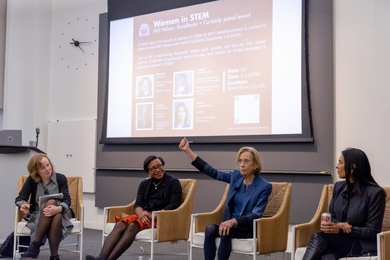In the mid 1950s, MIT and the eight Ivy League colleges acted to ensure that their resources used for financial aid would be made available in a "wise and responsible manner."
The nine universities created the mechanism known as Overlap as a way of coordinating their undergraduate financial aid programs. The name Overlap described undergraduate students who were admitted to more than one of the colleges and who sought financial aid.
MIT and the other universities acted out of their common belief that higher education is a "public good" that serves to maximize human capital in society and that a high quality post-secondary education should not be a privilege reserved for the wealthy.
These principles are identical to those embodied in the federal financial aid system.
The Overlap members made a commitment: Financial aid, deriving as it does from "scarce charitable resources," would not be awarded in excess of an applicant's demonstrated need.
Maintaining that commitment required a standard measurement for defining "need." Without that standard, Overlap's commitment to a need-based financial aid policy would have no meaning.
Overlap's members determined that aid administrators at individual universities could act more fairly, efficiently and accurately by sharing information and exchanging judgments about the particular circumstances of the applicant's financial need.
This need-based approach contrasts with that of many universities which offer merit or "non-need" financial awards. Athletic scholarships or scholarships based on artistic ability or some other form of academic achievement are common forms of merit-aid or non-need aid. Overlap schools which gave athletic scholarships (MIT does not) agreed to limit them to the demonstrated need of the student athlete.
All federal aid programs, and some private programs including MIT's, however, view merit aid as undermining the objective of greater educational access. The undermining occurs when funds used to provide merit aid reduce the pool of money available to aid qualified but needy students.
The Antitrust Division of the Justice Department claims that this reduction of available funds does not occur, or, if it does, is of no consequence. MIT, in its brief, says, "Both of these alternatives are remarkably out of touch with reality."
How did Overlap work in practice?
Financial aid administrators of Overlap schools met from time to time to pool their professional judgment on need analysis, including the determination of family contribution under Congressional Methodology. The purpose of these meetings was consistent with government efforts to achieve uniformity in the administration of federal financial aid.
Typically, they reached consensus on what was an appropriate way to treat various elements of need analysis, but it was understood that the schools were not bound to follow consensus in all cases. Each school remained free to determine need in individual cases-to "get it right," as the aid officers say-by considering all available information and basing decisions on any factors thought to be appropriate, while excluding the relative merit of the applicant.
Overlap schools acted independently in determining which students they wanted to admit, the level of financial aid each would receive and what family contribution would be required. This information was then exchanged so that each financial aid officer could examine the findings of Overlap colleagues.
Then, in the spring of each year, the Overlap aid administrators met to share the judgments they had arrived at individually on the financial need of students offered admission to more than one of the Overlap member universities.
In most cases, the independently determined family contribution was similar, accurately reflecting the true financial need of applicants.
In cases where the difference in proposed family contribution indicated the schools were acting upon different data or had considered factors other than need, supporting information was compared to determine why the schools involved differed.
A consensus was sought on that family's financial resources and need. If data from one school revealed to another school previously unknown family obligations, hardships or personal limitations, that school often increased its aid. On the other hand, in cases where it was found that a student's financial aid application to one school failed to list all available financial resources, the required family contribution was often increased.
In some cases the schools agreed on a middle ground between their individual determinations of required family contribution and in other cases they "agreed to disagree" and different financial aid packages were presented to the student.
A version of this article appeared in the May 13, 1992 issue of MIT Tech Talk (Volume 36, Number 30).





